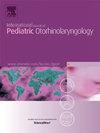Correlations between the pediatric sleep questionnaire and the pediatric overnight pulse oximetry
IF 1.2
4区 医学
Q3 OTORHINOLARYNGOLOGY
International journal of pediatric otorhinolaryngology
Pub Date : 2025-02-04
DOI:10.1016/j.ijporl.2025.112245
引用次数: 0
Abstract
Background
Since access to polysomnography is often limited, overnight pulse oximetry (OPO) is often used as an alternative despite its lower sensitivity. OPO can be an effective screening tool for sleep-disordered breathing (SDB), potentially indicating the presence of obstructive sleep apnea (OSA). OPO is also required for organizing postoperative monitoring following adenotonsillectomy. The Pediatric Sleep Questionnaire (PSQ) is a validated 22-item questionnaire that assesses OSA symptoms, of which the first six items report obstructive symptoms (obstructive subscale). Our study aims to determine the correlation between OPO and PSQ results and to evaluate if this questionnaire can be used to prioritize OPO for children suspected of OSA.
Methods
We conducted a retrospective, single-center study in a pediatric tertiary hospital involving 100 consecutive children. Participants were included if they were 2 years and older, had clinical suspicion of OSA, a completed PSQ, and a recent OPO result.
Results
The total PSQ score and the obstructive PSQ subscale have respective sensitivities of 80.4 % and 83.8 % for predicting SDB suggested by OPO. The sensitivity of the obstructive subscale increases to 90.9 % in children with adenotonsillar hypertrophy. However, the PSQ score isn't a reliable predictor of the severity of OSA as determined by OPO. The presence of comorbidities in children does not influence the correlation between the PSQ and OPO results.
Conclusion
The obstructive PSQ subscale is a quick, easy, and sensitive tool for predicting OSA diagnosed by OPO, particularly when there is adenotonsillar hypertrophy. The PSQ can prioritize children with high scores for OPO.
儿童睡眠问卷与儿童夜间脉搏血氧测定的相关性
由于多导睡眠描记术的使用经常受到限制,尽管夜间脉搏血氧仪(OPO)的灵敏度较低,但它经常被用作替代方法。OPO可作为睡眠呼吸障碍(SDB)的有效筛查工具,潜在提示阻塞性睡眠呼吸暂停(OSA)的存在。组织腺扁桃体切除术后的术后监测也需要OPO。儿童睡眠问卷(PSQ)是一份经过验证的22项问卷,用于评估OSA症状,其中前6项报告阻塞性症状(阻塞性亚量表)。我们的研究旨在确定OPO与PSQ结果之间的相关性,并评估该问卷是否可以用于对怀疑患有OSA的儿童优先考虑OPO。方法我们在一家儿科三级医院进行了一项回顾性、单中心研究,涉及连续100名儿童。如果参与者年龄在2岁及以上,有OSA的临床怀疑,完成PSQ和最近的OPO结果。结果总PSQ评分和阻塞性PSQ分量表对OPO预测SDB的敏感性分别为80.4%和83.8%。在腺扁桃体肥大的儿童中,梗阻性亚秤的敏感性增加到90.9%。然而,PSQ评分并不是由OPO决定的OSA严重程度的可靠预测指标。儿童合并症的存在不影响PSQ和OPO结果之间的相关性。结论阻塞性PSQ亚量表是一种快速、简便、灵敏的预测OPO诊断OSA的工具,特别是当有腺扁桃体肥大时。PSQ可以优先考虑OPO得分高的孩子。
本文章由计算机程序翻译,如有差异,请以英文原文为准。
求助全文
约1分钟内获得全文
求助全文
来源期刊
CiteScore
3.20
自引率
6.70%
发文量
276
审稿时长
62 days
期刊介绍:
The purpose of the International Journal of Pediatric Otorhinolaryngology is to concentrate and disseminate information concerning prevention, cure and care of otorhinolaryngological disorders in infants and children due to developmental, degenerative, infectious, neoplastic, traumatic, social, psychiatric and economic causes. The Journal provides a medium for clinical and basic contributions in all of the areas of pediatric otorhinolaryngology. This includes medical and surgical otology, bronchoesophagology, laryngology, rhinology, diseases of the head and neck, and disorders of communication, including voice, speech and language disorders.

 求助内容:
求助内容: 应助结果提醒方式:
应助结果提醒方式:


